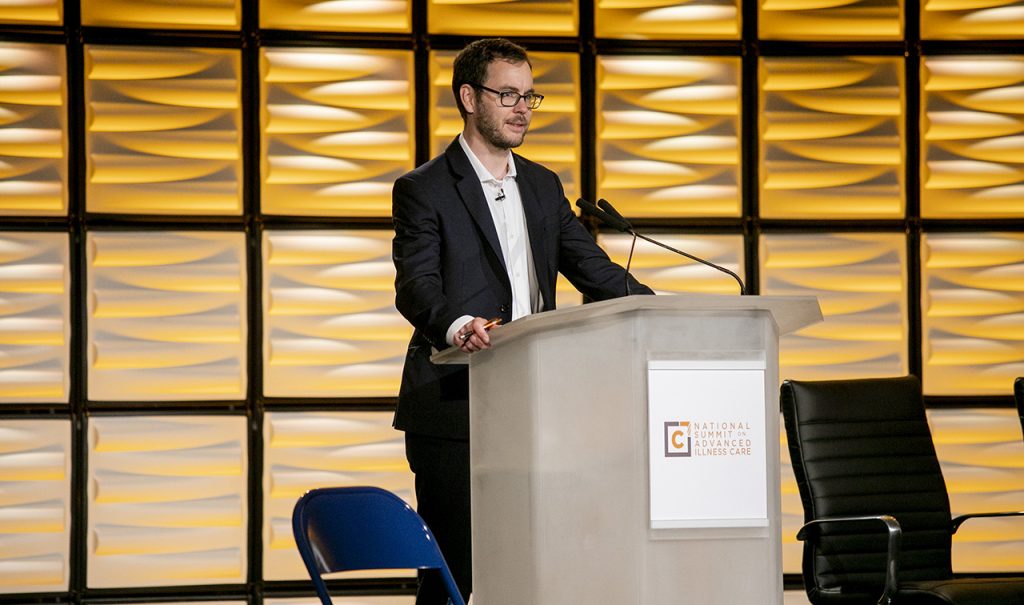HCCI participates in “special” C-TAC Summit on Advanced Care
There was something special about the National Summit on Advanced Illness Care held October 9-11 in Minneapolis, as the participating members of the Home Centered Care Institute (HCCI) quickly learned. That “something” was a mixture of collaboration, a continuous improvement mindset and a passion for the patient. A passion found in the meeting’s theme of “Lead. Innovate. Inspire.”
The summit, hosted by the Coalition to Transform Advanced Care (C-TAC), and sponsored by several organizations, including HCCI, brought together hundreds of providers, practices, organizations, innovators and thought leaders. Over the three days, the participants took part in presentations and panels, interactive “labs,” breakout sessions, exhibits and countless opportunities for networking.
One of the most compelling discussions at the Summit was between Jon Broyles, executive director of C-TAC, and “patient champion” Shirley Roberson, who shared her Blue Chair story focused on the critical importance of listening to, and honoring, a patient’s voice.
The summit also saw Broyles announce C-TAC’s new “moonshot” goal centered on providing millions of seriously ill patients with a high quality of life by 2030. (Learn more about what a moonshot goal is here.) In sharing his thoughts on the goal, Broyles explained, “Quality of life is the ultimate outcome we’re all seeking, not just during serious illness, but throughout our lives. The challenge is that each person defines it differently. We have to figure out how to quantify it because we must be accountable to Shirley and millions of others, and because groups like CMS [The Centers for Medicare and Medicaid Services] will need a formula to measure it.”
Where’s a good place to start with that definition of “quality of life”? According to Broyles, it’s asking ourselves what makes a good and joyful life, and what is the purpose of all the things we do, like going to work, getting married, having hobbies, and so forth? Then, he adds, we must ask that same question of each patient to see how they define it.
As with all big goals, Broyles discussed the fact that this is just the first iteration of the “moonshot” goal, and that the specifics, including the number of lives touched, could change over time. But, he explained, “It’s important to not only focus on the big numbers. If we only focus on the ‘millions,’ that can be too big, too overwhelming to understand and to really change behaviors. Instead, we at C-TAC say, ‘Millions start with one.’ What can we do to change one life? From that, others will follow.”
When asked how C-TAC and HCCI can work together, along with the other organizations in the advanced care space, to “focus on the one,” Broyles answered, “We’re all facing a significant human and societal challenge, where the need will so far outpace what individual groups can do, that we have to figure out how to do it together. We must be open to new ideas, while building on what’s working now. This includes thinking about the role that caregivers, volunteers, communities, employers and others play in supporting each patient.”
Focusing on the importance of taking into account the patient’s perspective in this collaboration, Broyles added, “We need to understand how patients experience care and view quality of life along a continuum. Then, all the providing groups, whether it’s palliative care, hospice care, home-based primary care or other models of care, must work together to create a seamless experience for the patient. The goal is an experience where patients’ needs are anticipated and met, without them having to do extra work or perform extra coordination to make it happen. After all, they have enough to think about and do.”
Reinforcing this focus on collaboration, HCCI presented a well-received video, entitled “The Intersection of Home-Based Primary and Home-Based Palliative Care.” In the video, Dr. Thomas Cornwell, CEO of HCCI and founder of Northwestern Medicine HomeCare Physicians, shared that, “Home-based primary care can add significant value to an existing home-based palliative care program. This effort can include providing education and technical assistance to palliative and hospice programs and the patients they serve.”
Watch for more information in future HCCI newsletters on how HCCI will be working together with C-TAC and other key partners to make person-centered care a reality for more of those who need it.
